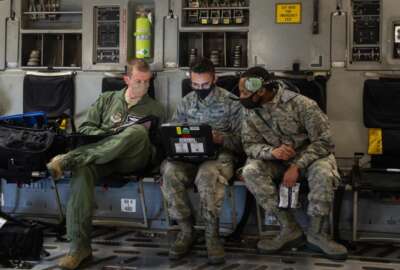

The General Services Administration has gone underwater with a reworked small business acquisition vehicle. Dubbed Polaris, the proposed vehicle is a replacement...
Best listening experience is on Chrome, Firefox or Safari. Subscribe to Federal Drive’s daily audio interviews on Apple Podcasts or PodcastOne.
The General Services Administration has gone underwater with a reworked small business acquisition vehicle. Dubbed Polaris, the proposed vehicle is a replacement for the failed Alliant SB-2. Now, don’t get too excited. The draft request for proposals won’t be out for months. But GSA is promising a lot of innovation in this vehicle. For more, Federal Drive with Tom Temin turned to federal sales and marketing consultant Larry Allen.
Interview transcript:
Tom Temin: I think the community of contractors was a little bit taken aback when they cancelled Alliance Small Business 2 after an avalanche of pre-award kinds of complaints. So what’s going on with Polaris now?
Larry Allen: Tom, Polaris is GSA’s attempt not just to replace Alliance Small Business 2, but to really take it a step further in terms of innovation. They publicly stated that they’re interested in newer small businesses, particularly companies that may not have done business on a government contract before that have innovative solutions. They’re really stressing this element of innovation. And they really want to make sure that small businesses feel welcome at GSA. I think they’re feeling a little bit that they had to cancel Small Business 2 for Alliant. But I think that was ultimately the right move. How they go about moving forward with Polaris Tom, and how quickly they can move forward, I think will be an indication of how successful the agency is in meeting the needs and accomplishing the goals they’ve set for themselves.
Tom Temin: Because in trying to attract non-traditional companies, innovative companies, the implication is companies that have not done business with the federal government before perhaps. Further, the best way to turn those people off is to take three or four years to get the whole contract vehicle going.
Larry Allen: Well, right. That’s exactly right. So I think there are two things here. One is pricing if you’re a new company that’s innovative, and maybe you’ve had some sales, whether to the federal government or in the commercial market, you’ve got a product or a solution that is showing some promise and some interest, it doesn’t mean that you have a static price file. GSA has the ability with Polaris not have contract level pricing, they said that that’s something they’re considering. I hope it becomes part of Polaris, because that will enable those innovative small businesses to come in more easily without having to construct something artificial on pricing to meet a GSA requirement. Leaving it at the task order level is going to be where these companies are familiar doing their pricing. The other thing that you mentioned is timing. GSA has now not had a small business IT GWAC for a little while since Alliant 2 Small Business never got off the ground Alliant 1 Small Business is over and out. They have some other contracts, 8(a) STARS, but they really need one that’s open to all small businesses that’s more of a broad spread contract. So I’m urging them Tom to move quickly. But the nice thing about having a good IDIQ contract, like an Alliant, like a GSA Oasis, or even the GSA schedule, is that it’s easy to order from those contracts once you get them in place. But the downside is it can take years to put them in place. Sometimes as long as five years. We no longer have that type of time to be able to put together something that’s considered innovative. Five years from now, if we’re just putting the Polaris contract into place, nobody’s going to equate Polaris with innovation because it took too long to bring to fruition. I’m challenging GSA to get their Polaris vehicle in place in time for FY 21 year end. Why not? If you’re going to not have pricing at the contract level, that’s less work for GSA, it’s less work for contractors. GSA has also talked, Tom, about having a frequent on ramp for this program so you don’t have to have everybody on at once. You can get the ones that are ready out of the box to get on the contract and add the other ones as they become ready to participate. There are lots of reasons why having an innovative acquisition vehicle is just as important as the innovation that can be bought through it.
Tom Temin: So in some ways, having regular on ramps would take this program, in some ways close to being like the schedule itself, which has continuous on ramps.
Larry Allen: That’s right. We started to see this already with Oasis where GSA has had frequent on ramps for Oasis for multiple pools in the program, and they’ve really expanded on purpose the scope of Oasis out in terms of the number of companies that participate. So there’s precedents for this in the GWAC world. When you’re looking for small business innovation and trying to get at these non traditional acquisition methods and ensure like, particularly for cybersecurity or national security, that the customers who have those missions get the best — having that type of vehicles important.
Tom Temin: And what about the possibility of non FAR acquisitions being able to occur through a vehicle like this such as OTA, if from those non traditional companies, an agency might be seeking some kind of a prototype?
Larry Allen: Well, we’ve seen some of this happen in other vehicles, kind of maybe the closest thing to it is order level materials in the GSA schedule construct, but also additional items for GWAC contracts, things that are generally within the scope of the underlying contract, but may not be specifically priced, they may not have a specific price because they’re more in a prototype stance than real production. I think that GSA is going to look long and hard to see whether that type of swim lane can exist inside a GWAC.
Tom Temin: And you’ve also written that the agency GSA plans to use good technology to drive contract management. And I guess that means also to drive cost out of contract management. So could this be a low overhead, low fee vehicle relative to schedule contracts?
Larry Allen: It certainly could, Tom. This is kind of wonky stuff. It does get into good government management. This is a high priority, not only the administrator Emily Murphy, but Julie Dunne, the FAS Commissioner to implement improved technology to manage all of GSA’s contract portfolios. That technology hadn’t been updated in decades in some cases. So now we have a big drive internally to automate processes that can be automated so that human contracting officers spend the time on the things they need to do, but not on the repetitive processes that can be part of a machine learning construct, for example, that argues for even more towards a faster ability to implement your program and lower program overhead if you don’t need as many human resources on it.
Tom Temin: So it sounds like the Polaris could be in some ways, a prototype for the next round of contracts and GWACs everywhere else in GSA?
Larry Allen: It certainly could be. We know that GSA is testing some of these features on the schedules program, Tom. But I think that in order to have a real sense of how a non-price contract is going to work, to have a real sense of how the new contract management technology is going to work — you want to have a larger experimental base to judge by to see what’s working, what needs tweaking. What better way to do that than to implement those features on a new program.
Tom Temin: And of course, the industry itself has a role to play here. And maybe they should not bury the request for proposals, the initial draft with protests and complaints.
Larry Allen: Well, I think that’s right. I mean, look, if you’re a company that has a legitimate concern, and you can’t get your questions answered, that’s what leads to protests. GSA usually does a pretty good job of answering questions. So we’ve all seen what happens when you overload a contract, a vehicle, with protests, it sinks to the bottom. This Polaris, the sub that is going to look for the sunken Alliance 2 SB contract. That’s hopefully a cautionary tale to limit protesting to those areas where it’s absolutely essential. But one of the things I think that GSA is trying to do, in addition to what we’ve talked about is that frequent on ramping so that there’s not a sense that, hey if you missed this now, you’re shut out forever. It’s not going to be that way. If you don’t qualify now, you could qualify in a year from now when there’s an on ramp, and hopefully that would be something that would get a potential protester to think twice.
Tom Temin: Larry Allen is a federal sales and marketing consultant and president of Allen Federal Business Partners. Thanks so much.
Larry Allen: Tom. Thank you and I wish your listeners happy selling.
Copyright © 2025 Federal News Network. All rights reserved. This website is not intended for users located within the European Economic Area.
Tom Temin is host of the Federal Drive and has been providing insight on federal technology and management issues for more than 30 years.
Follow @tteminWFED


